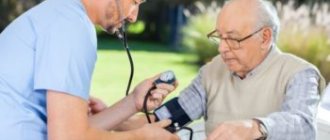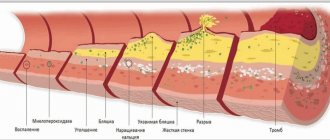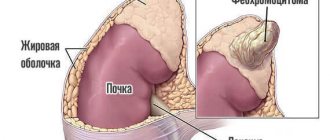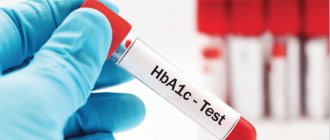Symptoms of high hemoglobin
Initially, it is necessary to sort out what complaints does a woman have with increased hemoglobin?
The condition of increased hemoglobin is called hyperhemoglobinemia and very often occurs without the manifestation of clinical signs. In most cases, high hemoglobin in women and men is detected only during a routine general clinical examination. In some cases, hyperhemoglobinemia is accompanied by the following symptoms:
- increased blood pressure and swollen veins;
- a feeling of aching in bones and joints;
- decreased performance;
- weakness and drowsiness;
- shortness of breath even when walking calmly;
- slight blueness of the fingertips;
- pallor or flushing of the face;
- losing weight for no apparent reason;
- decreased concentration and absent-mindedness;
- long and painful menstruation;
- neurotic disorders, psychoses, insomnia, depression.
Often the causes of high hemoglobin levels in women and men are a concomitant disease. In this case, the symptoms of hyperhemoglobinemia are similar to the clinical manifestations of the underlying pathology. This fact explains the difficulties for differential diagnosis of hyperhemoglobinemia itself and identifying its causes.
Hemoglobin during pregnancy
During pregnancy, elevated hemoglobin is extremely rare. As a rule, a single increase in Hb concentration is not significant, since the levels of all indicators change during the day against the background of physical or emotional activity. However, consistently high levels may indicate a lack of B vitamins or the development of a pathological process. In this case, a comprehensive examination of the patient is prescribed to eliminate the hyperhemoglobinemia condition as quickly as possible. This is necessary to reduce the risk of developing thrombosis and fetal hypoxia.
Pregnant women are more often characterized by a state of hypohemoglobinemia - a deficiency of hemoglobin levels against the background of blood thinning, as a result of an increase in its volume.
For early diagnosis of deviations from the norm when planning to conceive a child, a course of preventive measures is recommended to prevent a decrease in Hb concentration. This will significantly reduce the risk of developing any type of anemia.
Read further: What is hemoglobin in the blood, its types, how is it tested. How does alcohol affect? The influence of periodic women's days
What is increased hemoglobin and why is it dangerous?
Let's take a closer look at the causes of high hemoglobin and the treatment of this abnormality before it leads to serious health problems.
Hemoglobin is a protein that transports oxygen and carbon dioxide along the lung-cell route. The normal concentration for men is 140 g/l, and for women - 130 g/l. Doctors also note that each age category has individual indicators.
A change in the concentration of this protein by 20 units is considered a deviation from the norm. When hemoglobin decreases, doctors talk about the development of oxygen starvation (hypoxia), which can provoke premature tissue death. If the amount of protein increases excessively, then the number of red blood cells also increases.
And this, in turn, leads to blood thickening, which can cause serious disorders:
- thrombosis;
- stroke;
- heart attack;
- pulmonary thromboembolism.
Such consequences arise only due to the high concentration of hemoglobin and red blood cells. But the violation can be secondary, i.e. the result of any illness. And therein lies an even greater danger!
High hemoglobin in women - what does it mean and what should be done
Doctors are often asked the question - what does it mean if a woman has increased hemoglobin? As a rule, this condition is caused by a lack of oxygen in the blood. In order to compensate, the body begins to actively produce red blood cells containing Hb molecules.
To prevent the risk of developing complications in the form of thrombosis, mandatory correction of high hemoglobin levels is necessary. If such a condition is caused by external factors, then when they are eliminated, the Hb value returns to normal. In a situation where hyperhemoglobinemia is a concomitant symptom of the disease, initial elimination of the underlying pathology is necessary.
Reasons for the increase
Factors that cause an increase in hemoglobin levels can be exogenous (external) or endogenous (internal).
Exogenous causes. An increase in hemoglobin levels may be associated with a person’s type of activity. Thus, pilots, residents of high mountains and climbers who spend significant time at high altitudes experience hypoxia. Therefore, immediately after the flight, the Hb concentration will be higher than normal. Taking certain medications, such as steroids, also affects this laboratory indicator.
During long-term training with heavy loads, a huge amount of oxygen is consumed, which, with the correct technique, is compensated by frequent and deep breathing. If technology is violated, an increase in hemoglobin levels is observed in the body.
Endogenous causes. Diabetes mellitus and mental disorders accompanied by stress reactions can also cause Hb deviations from the norm. And in the case of a benign tumor process of the circulatory system (Vaquez disease), an increase in the concentration of red blood cells becomes malignant.
When taking medications that lead to excessive absorption of iron ions in the blood against the background of malfunctions of the enzymatic system, the Hb level increases.
Reasons for the downgrade
Low Hb concentrations are observed against the background of the following pathological conditions:
- anemia of various types;
- failures of hemoglobin synthesis processes;
- liver diseases;
- ulcers of the stomach and duodenum;
- chronic kidney disease, which results in a decrease in the concentration of the hormone erythropoiesin, the main role of which is the activation of the formation of red blood cells in the bone marrow;
- hypofunction of the thyroid gland;
- blood hemolysis - destruction of red blood cells;
- oncological diseases accompanied by metastases to the bone marrow;
- chronic pathologies of connective tissue;
- infectious process.
Read further: Tables of norms with explanations of indicators in a biochemical blood test
What you should know about increasing iron levels in the body
It is well known that iron is an essential element for all living organisms living in an oxygen environment. It is necessary for the transfer of oxygen (as part of hemoglobin) to all organs and tissues. Also, iron is part of the enzymes involved in “cellular respiration.”
The human body contains no more than 3-4 grams of iron and this amount is carefully maintained by regulating its absorption in the small intestine. The daily food requirement for this element is about 10 mg for men and 20 mg for women of childbearing age.
What factors affect iron levels?
Various factors influence iron levels in the body. The most important of which are: the amount of iron entering the body with food, taking medications containing iron, the fact of blood transfusion, the condition of the liver, the mucous membrane of the stomach and small intestine, the presence of blood loss, features of the menstrual cycle and hereditary causes.
If there is not enough iron in the body, iron deficiency anemia develops. But even more dangerous is the excess iron content, which accumulates excessively in the liver, spleen, and then in the skin, heart muscle, pancreas, thyroid and gonads, in the joints, which leads to an accelerated rate of “aging” and damage to these organs, growth in them connective tissue and disruption of their work. The risks of cirrhosis and liver cancer, diabetes mellitus, severe heart failure, and dysfunction of the thyroid and gonads increase.
The main reasons leading to oversaturation of the body with iron are genetic mutations, excessive intake of iron into the body from food (in red meat, wine, etc.), abuse of iron preparations (especially when administered intravenously), frequent blood transfusions, destruction (hemolysis ) red blood cells and chronic liver diseases.
Today, the high prevalence of iron oversaturation is known due to hereditary factors. This disease is called primary hemochromatosis, abnormal genes of which are detected in 1 in 250 residents of Northern Europe, and about the same number in Russia. Most often, this disease is detected in men over 40 years of age, less often in women after menopause.
Partially mutant genes for this disease may initially not manifest themselves in any way, but with the development of chronic liver damage, these genes are turned on, and the patient develops iron overload syndrome (IOS). Often, in approximately 20-30% of cases, this is observed with non-alcoholic and alcoholic fatty liver disease, viral hepatitis B and C.
How to suspect an oversaturation of the body with iron?
- If liver enlargement and/or changes in liver biochemical parameters are detected and their cause is not clear.
- If there is a chronic liver disease and, despite the treatment, “disturbed” biochemical parameters of the liver remain.
- If any examination reveals an increase in hemoglobin, iron, ferritin, transferrin in the blood.
- If you notice darkening of the skin on open areas of the body, hyperpigmentation and dry skin in the area of the armpits, groin folds, and old scars.
- If there are any combinations of diseases: liver cirrhosis, diabetes mellitus, joint damage, pathology of the heart and endocrine glands.
- If you have relatives suffering from hemochromatosis or PWS.
What to do if signs of iron oversaturation are detected?
If you identify signs of excess iron in the body, you should consult a doctor who specializes in the treatment of iron metabolism disorders, who will help you understand the cause of this condition, prescribe an examination plan, select the correct treatment and determine follow-up.
Methods for treating iron overload include: strict adherence to a diet limiting iron content to 8 mg/day, avoidance of alcohol, therapeutic bloodletting (phlebotomy), and the use of antioxidants.
Remember, iron accumulated in internal organs remains there forever! Therefore, timely detection and treatment of iron overload syndrome will prevent the occurrence and progression of damage to the liver and many other organs, the development of liver cancer and prolong your life.
GC Expert has developed a special program “Iron overload and hemochromatosis”, within which you can undergo an in-depth examination to determine the causes of iron overload and receive an individual treatment plan.
Treatment methods for high hemoglobin
High hemoglobin in women poses a serious threat, especially during pregnancy. Therefore, when diagnosing a pathological condition, mandatory treatment is necessary. How to reduce hemoglobin?
Treatment and correction methods for elevated hemoglobin in women are aimed at thinning the blood and reducing the concentration of red blood cells. For this purpose, for example, the following drugs are prescribed:
- aspirin®;
- cardiomagnyl®;
- chimes®.
Important: independent selection of medications and dosages for treatment is prohibited. Such behavior can lead to a worsening of the condition and severity of the disease.
It is acceptable to prescribe hirudotherapy - treatment with leeches. When a leech bites, the enzyme hirudin contained in their saliva enters the human bloodstream. Hirudin has a bidirectional effect on the blood: on the one hand, it slows down the processes of blood clotting, and on the other, it reduces the risk of blood clots. It should be noted that for therapy it is necessary to use only medicinal leeches sold in pharmacies and diluted in laboratory conditions. For one session, 5 leeches are enough, each of which sucks no more than 15 ml of human blood when biting.
Menu for women with high hb
In combination with drug treatment and hirudotherapy, it is necessary to adhere to a certain menu:
- the amount of red meat in the diet should be reduced, and offal (liver, tongue, kidneys) should be completely excluded;
- the diet should be dominated by white meat and low-fat fish;
- the consumption of legumes (peas, beans, lentils) is allowed, since iron, which predominates in their composition, is poorly absorbed by the human body;
- vitamin complexes containing folic acid and B vitamins are excluded;
- It is forbidden to consume juices and rosehip decoctions;
- You need to drink clean water without gas often and in small portions: every half hour - 1 glass of water.
Reduced hemoglobin
Low hemoglobin levels are often observed at different ages - both young and old.
Causes and symptoms
A lack of hemoglobin occurs when the body loses a large amount of it or receives little.
The main causes of low hemoglobin in older people:
• Monotonous food. Hemoglobin synthesis occurs thanks to foods containing iron, B vitamins, amino acids and food acids. If the diet lacks these substances, a person's hemoglobin level is reduced. A poor diet leads to a lack of this protein. For the same reason, low hemoglobin occurs in vegetarians. • Internal bleeding can cause hemoglobin deficiency. Women may experience gynecological bleeding. In men, various internal bleeding is possible: stomach, intestinal, kidney, nasal. Frequent blood loss leads to a lack of hemoglobin. • Severe infection • Chronic enteritis • Long-term use of IV drips • Excessive drinking
A reduced level of hemoglobin is associated with various disorders and internal problems in the human body.
If the level of this protein decreases without obvious reasons, examination by specialists is necessary. Low hemoglobin levels are a symptom of such problems, so the root cause needs to be identified and addressed. If you increase hemoglobin without finding out the root cause, it will return to normal only for a certain time.
Symptoms of low hemoglobin are the same for people of any age:
• dry skin • loss of strength and weakness • fatigue • dizziness • shortness of breath • palpitations
Anemia is a pathological condition that develops when hemoglobin decreases to less than 110 g per 1 liter. It occurs in almost half of people over 60 years of age. The development of anemia has nothing to do with age-related changes in the body: in a healthy pensioner, the blood functions in the same way as in a middle-aged person.
The appearance of anemia is influenced by diseases: frequent tumors, infections, diseases of the heart, autoimmune or endocrine systems, chronic illnesses. Such problems cause a decrease in hemoglobin levels, and its deficiency further aggravates the situation.
At the very beginning of the development of anemia, tests may be normal, but anemia already manifests itself in the first signs. Look out for these common symptoms of anemia:
• Dryness and paleness of the skin • The appearance of painful cracks in the corners of the mouth • Brittle and pale nails • Burning sensation and pain in the tongue • Brittleness and hair loss
Other additional signs of anemia subsequently develop:
• Fatigue, lethargy • Rapid breathing and pulse • Tinnitus • Frequent dizziness • Muscle weakness • Spots in the eyes • Difficulty concentrating • Fever • Irritability
At the beginning, there may be no symptoms or only dizziness and lethargy. With a further decrease in hemoglobin, these symptoms become more pronounced. With a large lack of hemoglobin, a person’s thoughts become confused and fainting is possible.
If a person discovers signs of anemia, he needs to go to the doctor for diagnosis and subsequent treatment. Treatment for anemia depends on its type. There are several types of disease. Let's look at them in order.
Types of Anemia
There are different types of anemia. In older people, four types are more common, which we discuss below.
• Anemia of chronic diseases (ACD)
It occurs due to many diseases: infections, autoimmune diseases, tumors and others. Anemia is not severe and is a symptom of an underlying chronic illness. Treatment is carried out by resolving the underlying problem. Iron supplements will not help with ACD.
• Iron deficiency anemia (IDA)
The most popular type. Occurs due to a lack of iron due to poor nutrition or blood loss due to internal bleeding. Characterized by a drop in iron levels and a less saturated color of the blood.
Bleeding is caused by internal diseases: gastric or duodenal ulcers, gastritis, intestinal angiodysplasia, diverticulosis, cancer. The development of IDA is also affected by chronic bleeding of the genitourinary system, bleeding disorders, stomach ulcers, colitis, Crohn's disease, tumors and others.
Iron-containing preparations are used in treatment. The main means for increasing hemoglobin are ferrous sulfate and ferrous gluconate. The medications are taken 3-4 times a day.
For better absorption of iron, vitamin C is recommended. Calcium, coffee, tea and wine interfere with the absorption of iron, so they should not be mixed in the same meal with medications and foods containing iron.
• Anemia caused by lack of folic acid
Folic acid deficiency is usually associated with poor diet. To replenish its reserves, appropriate medications and healthy nutrition are prescribed.
• Anemia due to lack of vitamin B12
Neurological signs appear before the symptoms of anemia: decreased sensitivity, muscle weakness, hyporeflexia. Then spasms and ataxia may develop.
The cause of this anemia is a decrease in intestinal absorption of vitamin B12. B12 deficiency can be observed in the following cases: gastric resection, diseases of the small intestine, vegetarianism. Vitamin B12 deficiency is treated by replacing it with medications.
Anemia in older people can be cured if treatment is started on time and all medical recommendations are followed.
Anemia is dangerous for older people and can lead to complications and serious consequences. Due to a lack of hemoglobin, immunity decreases, so a person becomes vulnerable to various viruses and infections.
If anemia is started, a severe lack of hemoglobin may develop, which will lead to health problems. At the third, severe stage of anemia, a person develops tachycardia, bradycardia, blood pressure increases, muscle atony, and fainting occur. Lack of hemoglobin leads to oxygen starvation of the brain, which can cause the development of Alzheimer's disease.
Anemia must be treated immediately, since in older people it quickly turns into chronic anemia. Women may develop tumors of the reproductive system, and men may develop dementia praecox. Anemia is three times more common in older men than in women. All retirees are advised to have regular blood tests to check and detect problems early on.
Diagnostics
If symptoms of anemia appear, a blood test should be done. This informative method helps the specialist determine the number of red blood cells, hemoglobin level, and the degree of anemia.
Anemia caused by a lack of folic acid or vitamin B12 is diagnosed in a differential manner.
They investigate the root cause of anemia and pay attention to chronic diseases. After a detailed diagnosis, suitable treatment is prescribed.
Treatment
Therapy is based on the following plan:
• Getting rid of the cause of anemia • Maintaining a healthy daily routine and maintaining a complete harmonious diet • Regular intake of iron supplements • Monitoring blood counts to prevent the risks of iron deficiency anemia
Treatment for low hemoglobin depends on the type of anemia.
With iron deficiency anemia, the amount of ferritin and serum iron in the blood decreases, and the iron-binding capacity of the blood increases. With IDA, the number of red blood cells in the blood decreases.
To get rid of anemia, you need to treat the root cause. For auxiliary treatment, iron-containing drugs are prescribed.
To raise iron levels to normal levels per day, a dosage of 150-300 mg of an iron-containing product is required 1-2 times a day. Typically, medications based on ferrous sulfate or fumarate are prescribed. It is better to take the product with food for better absorption.
It is necessary to carefully observe the dosage of medications, since drugs with iron can lead to side effects: disruption of the healthy functioning of the stomach, nausea and vomiting, constipation, vascular inflammation, allergies, hypotension, and chest pain. You cannot prescribe medications for yourself - the medications are prescribed by your treating specialist.
Means for increasing hemoglobin in the elderly must meet certain criteria:
• Contain sufficient amounts of ferrous iron. • Iron must be well absorbed - for this purpose special components are added to medications. • Dosages and use of drugs should be convenient for pensioners. • Funds must be affordable.
Iron levels can be increased through appropriate nutrition. You need to include foods rich in iron in your diet and combine them with medications.
Anemia due to deficiency of folic acid and B12 is characterized by a more saturated shade of blood. Red blood cells increase in size. There is a decrease in leukocytes and platelets, and the amount of iron in the blood serum increases. A person experiences neurological and mental disorders.
The causes of this anemia are:
• Gastritis, stomach cancer • Pancreatitis, diverticulosis • Inflammation of the small intestine • Dysbacteriosis • Chronic hepatitis
Anemia can be caused by improper use of medications or a lack of important substances in the body.
Bone marrow analysis is used in diagnosis. The person is also checked through research: a course of vitamin B12 is prescribed and the patient’s blood condition is monitored. If a person gets better and his blood counts return to normal, it means he has anemia due to a lack of B12.
Treatment is carried out with vitamins. Vitamin injections are given daily until blood counts return to normal. Next, to consolidate the result, vitamins are administered 1-2 times a month.
Anemia due to a lack of folic acid occurs less frequently for the following reasons:
• Frequent alcohol intoxication • Destruction of red blood cells, oncology, dermatitis, enteritis • Nutritional deficiency • Taking certain medications
In treatment, you need to pay attention to the root cause of anemia. If it cannot be eliminated, the person is treated with vitamins. The patient is prescribed folic acid injections or tablets at a dosage of 5 mg per day.
To quickly increase hemoglobin in an elderly person, suitable medications are prescribed. The medications prescribed vary depending on the type of anemia, concomitant diseases, and the condition of the elderly. For example, Hemobin is often prescribed. This remedy is well suited for older people, and its only contraindication is individual intolerance.
Elderly people are prescribed medications in tablet and liquid form for easier and better absorption.
Nutrition and traditional medicine for low hemoglobin
Hemoglobin in the body of an elderly person is produced thanks to foods rich in vitamin B, iron, amino acids and other food acids.
A suitable diet must be combined with medication. In the future, after recovery, you should adhere to a healthy diet to maintain normal hemoglobin. Folk recipes also provide nutritional recommendations for anemia and offer healthy herbal recipes.
Nutrition rules:
• Small meals 5-6 times a day. The last meal is at least 3 hours before going to bed. • Replace coffee and tea with herbal teas, vegetable and fruit juices. • Walk in the fresh air more often to normalize oxygen balance and stimulate hemoglobin renewal.
To increase hemoglobin levels, you need to introduce iron-rich foods into your diet. These include:
• Meat, meat by-products, fish • Egg yolks • Food made from whole grain flour • Nuts and seeds • Porcini mushrooms • Buckwheat, lentils, beans • Wheat germs and sprouts • Beets, carrots, cabbage, seaweed, greens (parsley, spinach, fennel) • Prunes, apricots, dates, figs, black currants • Strawberries, currants, pomegranate, yellow and orange fruits • Herbs, seasonings • Decoction of nettles and rose hips • Dried fruits, chocolate, halva, natural dark honey
Folk recipes and useful nutritional recommendations:
• There are soups made from rye and wheat bran. • Drink juice from pickled beets - 200 ml per day. • Nettle decoction or tincture – take 20-25 g before bed. • It is useful to eat carrots, apples and parsley. • Dried apricots are an excellent dried fruit for increasing hemoglobin. You should eat seedless in small quantities every day. • Drink whole milk.
Several recipes to increase hemoglobin:
• Decoction of meadow clover. Pour clover heads (10 g) with a glass of water and brew, strain after 45 minutes. Take 3 times a day, two tbsp. l. • Rosehip infusion. Pour one tbsp. l. rosehip berries with one glass of boiling water and leave to infuse for several hours. You can drink it instead of tea three times a day. • Vegetable juice. Peel and wash the beets, carrots and black radishes. Finely grate and squeeze the juice from each vegetable. Mix in equal parts and place in the oven for 3 hours. Then take the product one tbsp. l. in a day.
When choosing a traditional recipe, consult your doctor. You need to eat harmoniously and fully, be sure to have breakfast, lunch and dinner. The diet should be higher in calories in the first half of the day, and it is better to have a light dinner. Along with meals, you can use suitable folk remedies, for example, teas or decoctions.
Natural juices are very useful for increasing hemoglobin and are well absorbed. The following juices are suitable for anemia:
• Pomegranate. It is diluted a little with boiled water. Consume three times a day half an hour before meals every day for 2-3 months. • Birch. You can drink in large quantities - up to 4 glasses a day. It will protect against fatigue. • Beetroot. It is recommended to drink 100 ml of fresh juice daily for a month. • Carrot-spinach mixture. It is recommended to drink 100 ml three times a day. • Juice from dandelion leaves. Drink 50 grams once a day for a long time.
If you have anemia, you should not starve, overeat, or take long breaks between meals. Portions should be hearty and moderate.
In old age, you should not get carried away with interesting nutritional systems and varied diets - it is better to eat a nutritious diet and follow healthy recommendations.
If a person has lost teeth or they are in poor condition, this must be taken into account when preparing food. Food should be prepared soft so that it is easy to chew, and liquid dishes should be used. You can use a blender or grater to grind food.
With the help of suitable nutrition, anemia can be eliminated at an early stage of development. By combining nutrition and traditional medicine over a long period of time, it is possible to normalize hemoglobin levels in a short time. After a month, it is recommended to take a blood test to check. If hemoglobin is not yet normal, treatment is continued.
How to raise hemoglobin levels: useful tips
You need to lead a healthy lifestyle. Healthy recommendations include:
• High-quality nutrition - several times a day. A varied healthy diet, including all useful vitamins and substances. • Give up vegetarianism and bad habits. • Treat diseases in a timely manner, maintain normal condition in case of chronic illnesses.
In old age, you need to be prepared for long-term treatment due to the health status of the elderly person. With a competent approach, the symptoms of anemia gradually go away, and the person begins to feel better.
Diagnostic methods and preparation
Diagnosis of hemoglobin level is mandatory when conducting a general blood test. The duration does not exceed 1 day. The biomaterial for analysis is venous or capillary blood. To obtain the most reliable results, you must follow the preparation recommendations:
- eliminate fatty and fried foods for 1 day;
- blood is donated strictly on an empty stomach, the last meal taken at least 8 hours before;
- within half an hour, physical and emotional stress is limited;
- You must not smoke for 1 hour.
Interpretation of results and norm
Important: the interpretation of the data obtained should only be carried out by the attending physician.
Otherwise, the risk of incorrect diagnosis and selection of treatment methods that will worsen the patient’s condition cannot be excluded.
Reference (normal) values are selected individually for each patient, taking into account gender, age and menstrual cycle.
| Floor | Age | Hemoglobin norm, g/l |
| Both | 0 – 14 days | 135-200 |
| Up to 1 month | 100-170 | |
| 1-2 months | 95-130 | |
| 2-4 months | 100-140 | |
| 4-6 months | 110-140 | |
| 6-9 months | 100-150 | |
| 9-12 months | 115-145 | |
| 1-5 years | 110-150 | |
| 5-10 years | 115-145 | |
| 10-12 years | 120-160 | |
| Man | 12-15 years | 120-160 |
| 15-18 years old | 120-170 | |
| 18-45 years old | 130-170 | |
| 45-60 years | 140-175 | |
| Over 60 years old | 120-175 | |
| Woman | 12-15 years | 110-150 |
| 15-18 years old | 120-155 | |
| 18-45 years old | 115-160 | |
| 45-60 years | 120-160 | |
| Over 60 years old | 110-170 |
It should be noted that even with a normal quantitative content of red blood cells in the blood, a deviation from the reference values of the Hb indicator may be observed.
A small one-time deviation from the norm is not a cause for concern. In other words, if hemoglobin 160 is detected in a patient under the age of 18, then there is no need for additional laboratory and instrumental examinations.
Despite the difference in normal values for different sexes, hemoglobin 150 g/l is considered the optimal value for both women and men.
Symptoms of decreased hemoglobin levels
The severity of symptoms depends on the level of hemoglobin and the degree of iron deficiency. So, in mild cases, women may notice periodic weakness and increased fatigue or even not pay attention to it. As the problem worsens, the intensity of the symptoms will increase, as will other manifestations.
In general, low hemoglobin levels in women can be manifested by the development of asthenic syndrome, i.e.:
- increased fatigue, drowsiness;
- dizziness, headaches;
- palpitations, heart rhythm disturbances;
- shortness of breath that occurs after physical exertion, and in severe cases even after minor effort;
- tinnitus;
- loss of appetite;
- nausea, diarrhea or constipation.
All this may be accompanied by the occurrence of:
- brittle nails, the appearance of white spots;
- pallor of the skin and mucous membranes, peeling of the skin;
- problems with hair loss or slower growth;
- cracks in the corners of the mouth;
- irritability, apathy;
- deterioration in concentration;
- menstrual irregularities;
- swelling of the lower extremities.
Sometimes women, with a decrease in hemoglobin, have a desire to eat inedible things, in particular minced meat, raw dough, chalk, or to inhale the smell of gasoline, nail polish, hair dye, etc.
Consequences of increased hemoglobin in women
High hemoglobin levels are dangerous for women due to complications that affect the functioning of various systems and organs. Thus, an increase in blood viscosity leads to the formation of clots, which can cause bleeding, pulmonary thromboembolism, stroke, heart attack or thrombosis. Any of these conditions requires immediate assistance from medical personnel, since it threatens the life and health of the patient.
Hyperhemoglobinemia is especially dangerous for people with chronic diseases of the lungs and cardiovascular system, since their risk of developing thrombosis increases several times. Timely monitoring of Hb level concentrations is necessary during and after treatment of pathologies.
Normal levels of protein in the blood of an elderly person
Indicators of a person’s blood condition must be within normal limits. But it changes throughout life, and the norms differ between men and women. In women, this hemoglobin indicator throughout life varies from 120 to 155. And in men, from 130 to 160. If, according to the results of the analysis, the indicator does not correspond, then it needs to be increased or decreased depending on the results. After all, even the slightest non-compliance with the norm negatively affects overall well-being, weakness and lethargy appear, and immunity decreases.
Experts in this field identify several reasons why the hemoglobin content in the blood may be low:
- Loss of a large volume of blood for any objective reasons;
- Poor nutrition. Too monotonous diet with a clear lack of vitamins;
- Bad habits, including alcohol and cigarette abuse;
- The presence of a variety of infectious chronic diseases;
- The indicator may be lowered due to treatment with antibiotics, IVs and other potent medications.
Symptoms of hemoglobin in the blood that does not correspond to the norm
For most older people, this figure is below 110 g/l. And this is a clear indicator of a disease such as anemia. It occurs much more often in the male population than in women. There are a huge number of reasons for the appearance of such a disease: these include infections around us, tumors and oncology, as well as chronic diseases of the cardiovascular, endocrine and autoimmune systems of the body. Chronic diseases with internal bleeding also affect the decrease in hemoglobin in the blood; ulcers are a typical example. The state of hemoglobin is also affected by a lack of vitamin B12 and folic acid.
Insufficient hemoglobin levels in the blood are characterized by very dry skin, sweetness, lack of strength, headaches and dizziness . It is also typical for people suffering from anemia to experience severe shortness of breath with minimal walking and rapid heartbeat.
In addition to the above symptoms, there are several more characteristic of anemia:
- Pale skin, especially dry skin on the face;
- Constant fatigue, desire to constantly sleep;
- Weakened muscles and heaviness in the body;
- Constant ringing in the ears;
- Frequent long-term headaches;
- Periodically appearing cloudiness in the eyes;
- Depression, irritability and anger;
- Constantly elevated body temperature slightly above 37 degrees;
- Chapped lips, especially in the corners of the mouth;
- Brittle nails, their cracks;
- Brittle hair with split ends and frequent hair loss.
The poor condition due to anemia is aggravated by a significant decrease in protein levels in the blood. So if it reaches 60 g/l, clouding of consciousness and frequent fainting occur. In this case, it must be urgently increased with medications.
Prevention of elevated hemoglobin
Preventive measures against increasing the concentration of Hb in the blood consist of maintaining a healthy lifestyle:
- cessation of alcohol abuse, smoking and psychotropic drugs;
- maintaining a proper diet;
- drinking large amounts of clean water without gas;
- limiting physical and emotional overload;
- health status monitoring – annual scheduled examinations and maintenance therapy for chronic diseases.











